1. Earth as a unique plan
In the primary classes, you have learned that the Earth is an enormously big spherical ball. You may have wondered that to you Earth appears flat and not a spherical ball. It is because, at any place on the surface of the Earth, we do not have a full view of the Earth.
However, the astronauts traveling in space-ships have observed the Earth from large distances and taken its photographs. These photographs show that Earth is a spherical ball (Figure).
The Earth revolves around the Sun in a nearly circular path, which is commonly called the orbit of Earth. It completes one revolution around the Sun in 365¼ days.
The Earth as seen from the moon

The orbit of the Earth around the Sun
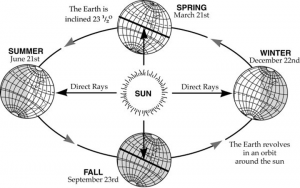
The Earth also rotates about an imaginary axis, as it moves along its orbit. Due to this rotation of the Earth, different parts of it face towards the Sun one by one. It is due to the rotation of the Earth that day and night are formed. Furthermore, the axis of the Earth is tilted to its orbit at an angle of 23½. This helps in the formation of seasons as the Earth moves along its orbit. The earth appears stationary.
It is because all the things around us on the surface of Earth move at the same speed. Thus, to an observer, nothing appears to move relative to one another and hence, the Earth appears stationary.
Our solar system (Figure) has eight planets, namely Mercury, Venus, Earth, Mars, Jupiter, Saturn, Uranus, and Neptune. Depending on their distance from the Sun, Earth is the third planet. It is a unique planet in the sense that it is the only planet in the solar system which supports life.
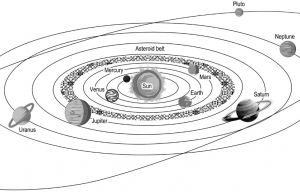
Solar system
Reason For Life On Earth
Look at the figure. You find that the planet Mercury is closest to Sun and Neptune, the farthest. Mercury being closest gets too much of the sun’s heat, and therefore no life is possible on this planet.
Our planet Earth is indeed unique and the features which are favorable for the existence of life on this planet are as follows —
1) Presence of essential elements: Proteins are the building blocks of life. Proteins contain carbon, hydrogen, oxygen, and nitrogen as the essential elements. The Earth contains these elements of insufficient amounts. It is these elements that first combine to form simple molecules. The simple molecules then combine to form complex molecules of proteins.
2) Presence of oxygen: Life can function only if there is a way to release a controlled amount of energy within the body of living beings. This is possible only when oxygen reacts with food materials during respiration. The Earth has a large amount of oxygen in the atmosphere, which is essential for respiration.
3) Presence of water: Water is extremely essential for all forms of living beings. Water regulates body temperature and also various body systems of living beings, such as nutrition, respiration, excretion, etc. The Earth has vast reserves of water, which is essential for. life.
4) The temperature of Earth: The temperature on the surface of planet Earth is neither too low nor too high. The temperature at most of the places on the Earth varies between –20°C and 48°C. In this temperature range, one or another life form can sustain itself
5) Presence of atmosphere: Some of the rays coming from the Sun are extremely harmful to live beings. These can cause instant death in some organisms. The atmosphere acts as a protective blanket. It absorbs the harmful radiations of the Sun. Furthermore, the atmosphere helps in the even distribution of heat energy from the Sun and in the formation of important elements of weather, such as clouds, rains, snow, etc.
6) The right amount of mass and gravitational force: The Earth has the right amount of mass. It is this mass that produces strong gravitational force. This force pulls the bodies on or above the surface of the Earth inwards. This not only keeps the things on the surface of the Earth in place but also holds the atmosphere and the oceans in place.
7) The right distance of the Earth from the Sun: The distance of the Earth from the Sun is 149,600,000 km. Most of the places on the surface of the Earth receive the right amount of solar heat and the temperature stays between -20°C and 48°C. This temperature is just right for sustaining life.
2. STRUCTURE OF THE EARTH
Firstly, there is the planet Earth itself, called the geosphere. The outer, rocky part around the Earth (the geosphere) is called the lithosphere. The depressions in the lithosphere are filled with vast oceans and are called the hydrosphere. About 70 percent of the earth’s surface is hydrosphere.
Surrounding the lithosphere is an envelope of air, known as the atmosphere. The atmosphere is divided into a number of layers, the lowest being the troposphere, followed by the stratosphere, and finally, the ionosphere which is 80 km from the surface of the Earth. Most of the weather formation takes place in the troposphere.
Thus, the planet Earth consists of three parts — (i) Lithosphere, (ii) Hydrosphere, and (iii) Atmosphere.
Inside of the Earth (geosphere) is also made of layers (Figure). At the center is a solid inner core made up of iron and nickel under very large pressure. Surrounding the inner core is the outer core which is liquid in nature and is mostly made up of iron, nickel, and sulfur. Surrounding the outer core is the mantle, which is 2900 km in thickness. It is made up of molten light materials, commonly called magma. The magma within the mantle rises up and falls down as a result of the heating and cooling of magma.
The most important layer of Earth from the point of view of all living beings, including human beings, is its crust.
Inside the Earth
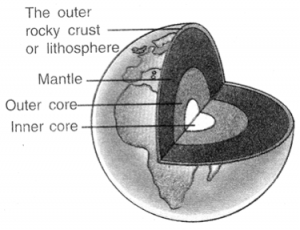
The Earth’s crust provides all the materials necessary for the growth and existence of life.
The Earth’s crust contains these materials in various forms such as rocks, soil, water, and air. The materials which are found in the Earth’s crust are called minerals. Coal, petroleum, natural gas, limestone, sand, common salt, ores of metals are examples of common minerals. The minerals which are found in the fertile soil or water are essential for all living beings.
The materials and minerals found within the Earth’s crust play an important role in the lives of human beings, especially for their comfort and leisure. Coal and petroleum products mined from the Earth’s crust provide for the energy needs of human beings. Metals like gold, silver, copper, aluminum, iron are used in making jewelry and various kinds of machines and shutters. The sand, the clay, and the limestone are used for making pottery and cement.
Composition Of The Atmosphere
The atmosphere contains a mixture of the following gases:
(i) Nitrogen 78% (approx.)
(ii) Oxygen 21% (approx.)
(iii) Carbon dioxide (0.03% to 0.04%)
(iv) Noble gases 0.9%
(v) Water vapor (approx. 4% of the total volume of air)
Besides the above gases, the lower layers contain sulfur dioxide gas, carbon, dust particles, salts and pollen grains, etc. In the upper layers of air, the percentage of oxygen drops rapidly. It is on account of this reason that the mountaineers carry oxygen cylinders with them. Similarly, high altitude fliers carry oxygen cylinders.
Compared to the size of Earth, the thickness of the Earth’s atmosphere is too small. 99% of air is found up to the height of 30 kilometers above the surface of Earth.
The gases present in the atmosphere are important for life to exist. Oxygen is required for respiration and carbon dioxide is required by the plants for photosynthesis.
The atmosphere also contains another gas called ozone which is extremely useful for living beings. Ozone prevents the harmful ultraviolet rays from reaching the Earth. It, thus, acts as a protective layer.
Importance Of Atmosphere
- It acts as a protective blanket for the Earth. It absorbs most of the harmful radiations such as ultraviolet radiations and X-rays coming from the Sun.
- Uneven heating of the atmosphere sets up wind cycles. These wind cycles help in circulating the air and also cause rain.
- The circulation of the air produces different climatic zones. This, in turn, has produced different kinds of plants and animals in different regions.
- It is a source of oxygen, which is required for respiration by all the plants and animals.
- It provides oxygen for burning fuels for various domestic or industrial purposes.
3. ENVIRONMENT
Moon is not a good place for life to exist. The Earth is the only planet in the Solar System where life is found. Plants and animals exist on the Earth because it has all the favorable conditions required for the survival of life.
Even on Earth, life is not found everywhere. The part of the Earth where plants and animals exist is called the biosphere. We find a variety of plants and animals occur in different places. While some of the plants and animals may be common, some may be different. At different, places different climatic conditions are prevalent. In some places, it may be too hot and in others, it may be too cold. Similarly, some places may be dry while others may be having heavy rainfall. The plants and animals have become adapted to their surroundings. Look at the plants found in a lake and those in a desert area. The differences which you find related to the environment of the plants. Air, water, and soil form part of the surroundings of plants and animals including man.
Living organisms do not live in isolation. All living things interact with one another and also interact with the non-living surroundings in which they live.
The term environment is used to denote all living and non-living things. In other words, the living organisms and their surroundings constitute the environment.
4. COMPONENTS OF THE ENVIRONMENT
Environment broadly has three components:
(a) Plants and animals, called biotic or living component; and
(b) Non-living – air, water, light, temperature, clouds, and soil, called abiotic or non-living component.
(c) There is one more component of the environment, called the cultural component which consists of the human influences on the environment.
Under natural conditions, both biotic and abiotic components together constitute the natural environment. Man is a dominant part of the natural environment and is the only organism on this planet that has the capability to change the natural environment. Man’s ever-increasing numbers and his greed to possess more and more physical comforts of life have greatly modified the natural environment. This modified natural environment or man-made environment is also termed a socio – cultural environment.
The socio-cultural environment has adversely affected the quality of our environment. We do not have clean air to breathe, safe and clean water to drink. Instead, we have congested roads, a highly polluted atmosphere, and a large number of tall buildings and industries to cope with the increasing population.
Terms Related To The Components Of Environment
The following terms are often used while studying the living organisms and their interaction with their surroundings.
Habitat: The place where the organisms live is called the habitat. A plant or an animal is adapted to survive in its habitat. For example, the habitat of a lion in the forest.
There are many types of habitats (Figure). Various physical factors like temperature, light, rainfall, and soil conditions are not the same in different habitats.
Population: A population is the total number of individuals (of plants or animals) of the same kind living in one area.
Different habitat
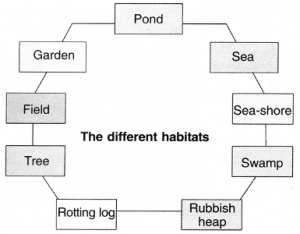
Community: A community is all the plants and animals that live together in one area or habitat. A community, thus, includes the different populations of plants and animals that exist in an area. The different populations depend on one another. For example, plants provide food to animals. They keep the air fresh by returning oxygen to the surroundings. They also provide shelter to the animals from predators, heat, and rain. In turn, animals provide carbon dioxide to the plants for manufacturing food (photosynthesis). Animals provide nutrients after their death and decay to the plants.
Ecosystem: The plants and animals together with the non-living environment in a given habitat form an ecosystem. The plants and animals in an ecosystem interact with each other and with the environment to produce all the materials they need for their existence. Thus, an ecosystem is a self-contained unit.
5. LIVING OR BIOTIC COMPONENT
(i) The living component consists of plants and animals including humans.
(ii) Plants, more specifically green plants that manufacture food, are called producers.
(iii) Animals feed on plants directly or indirectly. Animals which feed directly on plants like cow and goat are called herbivores or plant-eaters.
(iv) Animals that eat herbivores, such as lions. Such animals are called carnivores or animal eaters.
(v) Herbivores and carnivores are together called consumers, as these cannot manufacture their own food and consume plants or animals, as their food source.
(vi) Some organisms which cannot be seen with the naked eye, called micro-organisms, form a part of the living component. Bacteria and fungi and such organisms.chlorophyll
(vii) Green plants prepare food by the process called photosynthesis. Using carbon dioxide from the air and water from the soil, they prepare food in the presence of sunlight and green pigment, chlorophyll.
(viii) Animals, on the other hand, are called heterotrophs as they cannot prepare their own food and depend on plants.
(ix) In addition to producers and consumers, there is another category of living organisms that derive their food from the dead and decaying plants and animals. These are called decomposers, as they decompose the dead decaying matter.
(x) Decomposers are important in the cycling of nutrients or minerals in nature
(Figure).
(xi) Micro-organisms such as bacteria and fungi act as decomposers.
(xii) These micro-organisms convert the dead bodies into simpler compounds like CO2, N2, H2O, H2S, etc. which enter the soil or are released into the atmosphere.
(xiii) These simpler compounds can then be used again by the plants. This is how minerals are recycled in nature.
(xiv) Animals that feed on dead flesh are called scavengers.
Examples: Hawk, crows, jackals, vultures.
Cycling of minerals by decomposers
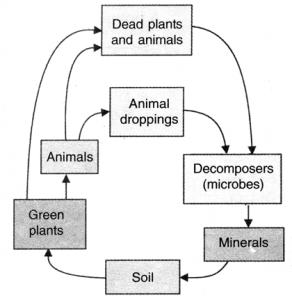
Plastic Bags!
These days, you may have heard a lot about the ban on the use of plastic bags. Why so? Why people are advised to use paper bags rather than plastic ones? This has something to do with the role of decomposers. Certain items like vegetables, fruits, leaves, paper, and cloth get easily decomposed, while others like plastic bags and bottles are not degradable.
Paper, garbage, and cloth are termed biodegradable and plastic is called non-biodegradable. Biodegradable items undergo cycling, whereas non-biodegradable ones cannot be recycled and adversely affect the environment and cause air pollution on being burnt.
Interactions Between Living Things And The Non-Living Surroundings
Living organisms (biotic components) require nutrients (abiotic components) for sustaining life. In an ecosystem, as discussed above, the cycling of nutrients or minerals takes place from the living to non-living components and vice versa. This cycling of minerals is made possible through the activity of decomposers.
The simpler substances so produced are taken up by the green plants, through the soil as well as through the atmosphere. Whether it is life on land or in water, the energy produced by green plants in the form of food materials flows through the consumers, thus making animal life possible.
Finally, the decomposers do their bit in releasing the nutrients from dead and decaying plant and animal life.
Through this interaction between living and non-living components, an equilibrium is maintained in the biological world in terms of nutrients and energy.
A food chain shows the food relationship among plants and animals
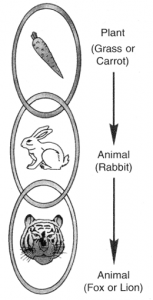
Food Chains
All living things need food to live. If they are starved of food, they get weak and finally die. As described above, plants are the food producers, while animals are food consumers.
A food relationship exists between plants and animals. In this relationship, one living thing is consumed by another and is shown by a food chain(Figures).
A food chain is a diagram or a chain showing what animals eat, or a chain showing the process of “eating and being eaten”.
Each arrow in a food chain means “is eaten by“. In the example given above, the grass or carrot is eaten by the rabbit, and the rabbit is eaten by the fox or lion.
The last link of a food chain is occupied by the decomposers.
Examples of food chains:
A food chain
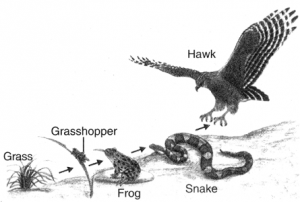
The general plan of a food chain, as evident from the above examples, is:
Food Web
In nature, simple food chains do not operate. Rather, a number of food chains are interconnected. This is because green plants are eaten by several plant-eaters (herbivores). These plant-eaters are, in turn, eaten by several animal-eaters (carnivores). The animal-eaters may be eaten by other animal-eaters. In this way, many food chains become linked together to form a food web(Figure).
A food web
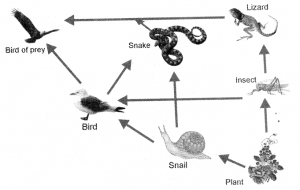
Energy Pathways
In a food chain, the transfer of energy takes place from one organism to another in the form of food transfer from producers to herbivores to carnivores. In other words, food chains show energy pathways or energy flow. In this energy flow, Sun is the primary source of energy (See Figure given below ).
Energy from the Sun is used by plants to make food. This energy then goes to all animals through the food chain. Eventually, the food stored in plants and animals is broken down into simple substances by decomposers. Plants make use of these simple substances as food.
The figure given below shows how plants and animals depend on the Sun as their source of energy.
Energy flow: From the sun to the plants and animals
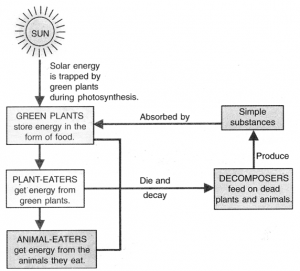
6. ABIOTIC COMPONENTS
The abiotic component of the environment is influenced by a number of factors. Temperature, light, water, air (oxygen and carbon dioxide), rocks, soil are all factors that influence the existence and survival of organisms. These factors are often called physical factors, constituting the physical environment of the organisms.
Temperature
The temperature is measured by a device called a thermometer and is a measure of the degree of hotness. Most plants and animals grow well in warm places, but some need a cold climate. For example, polar bears and penguins are found in cold places. They cannot survive in warm (tropical) jungles. On the other hand, tigers and elephants live in warm jungles and are not found in cold places.
Pine trees are found in cold places such as the slopes of mountains or in cold (temperate) countries. Plants and animals growing in cold places may not be able to withstand the high temperatures of deserts.
In India, cows and buffaloes are used for milk. Cows can tolerate hot weather whereas buffaloes cannot bear the summer heat. It is for this reason that you often see buffaloes cooling themselves in a pond, and not the cows. This adaptation to weather conditions is related to skin color.
Adaptations of Camel
Camel, popularly known as “the ship of the desert“, can tolerate the high temperature of deserts. Camel has adapted, and developed mechanisms to live in hot weather. Some of these adaptations are given below:
(i) It is capable of adjusting its body temperature to that of the surrounding desert habitat and thereby the water loss by perspiration and other means is drastically minimized. The human body temperature is 37 °C and if we are in a desert (where the temperature could be as high as 45 °C) we perspire a lot and it may even lead to dehydration of the body. This is because we have no ability to cope up with the high temperature of our surroundings, unlike camels. The camel copes with external high temperature by raising its own body temperature upto42 °C.
(ii) Camel can live without food or water at a stretch for as many as 10 days. When there is no water available to drink, it passes about half a liter of urine which is 10-20 times less than what it passes when water is available.
(iii) When water is available, the animal can drink about 3 buckets of water (50 liters) at one time and this water is not stored in a particular part of its body but is evenly distributed all over the animal’s body in tissues.
Adaptations of cacti and opuntia
Plants like cacti and opuntia have adapted to live in hot desert areas. The stem in these plants has become spongy, so as to store water. Leaves have been reduced to spines in order to reduce the loss of water from the plant’s surface. The function of the leaf has been taken over by the stem which has become green.
A cactus plant
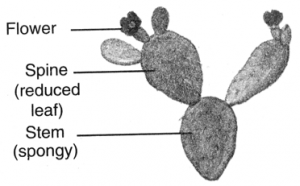
Light
Green plants need light to make food. They also need light to grow. They do not grow in dark places. In the absence of light, the leaves turn yellow.
Animals such as earthworms, centipedes, millipedes do not like light. They move away from light. These animals are usually found in dark places such as under a log of wood, in leaf litter, or under the ground (inside the soil).
The ultimate source of light and energy is the Sun. Flowers in Portuhca (dhoopkhirri)plant bloom after sunrise and close down after sunset. Similarly, in Bauhinia (kachnar) leaves open during the daytime and closes or folds during the night.
Water
All living organisms need water for their sustenance. This life-sustaining natural resource covers 4/5th of the earth’s surface. It makes up 60-70 percent of our body weight. Water is required for growing crops, in industry, and for human existence (drinking, cooking, cleaning, etc.). Of the total water available in the country, 97 percent is found in oceans (marine mm water) and only 3 percent represents freshwater found in rivers, lakes, and streams. Rain and snow are the principal sources of freshwater.
Temperature requirements of plants and animals
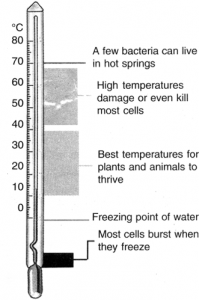
Adaptations by water plants
Cacti and camels are among the few plants and animals which can live in dry places like deserts. They have special water-storing organs in their bodies or other modifications as discussed above.
Just as plants and animals have adapted to live in water-scarce areas, they have also developed mechanisms to exist in water only. Plants like water lily, Lemna, and Eicchornia occur in water with floating leaves. Leaves in water lily are large and circular, floating on the surface of the water. Also, a waxy waterproof coating is present which prevents their decay in water.
In plants like Hydrilla, the leaves are present inside water. The leaves in such plants are long and thin so that the strong water currents are not able to tear them apart.
Water lily
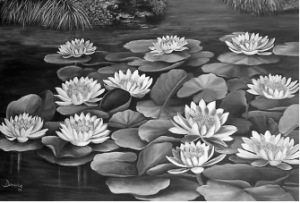
Hydrilla
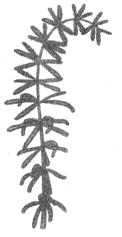
Air
Animals and plants require oxygen to stay alive. In the absence of oxygen, most organisms cannot respire and produce energy. As a result, they die.
Adaptations In Fruits
(a) Dandelion fruit with hair
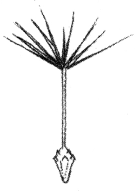
(b) Maple fruit with wings
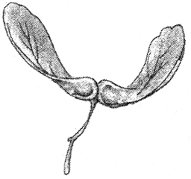
Plants, in addition to oxygen, also require carbon dioxide to make food. This carbon dioxide is present in the air and is produced by plants and animals during the process of respiration.
The cycling of oxygen and carbon dioxide between the biotic and abiotic components is essential to keep their balance in nature. These days, this balance of gases in nature has been upset by the activities of humans. Carbon dioxide concentration in the atmosphere is going up, leading to an increase in temperature and thus warming of earth (global warming). This has very serious consequences for the existence of even our own race. This explains why we need to plant more and more trees.
Air, when strong in the form of air currents, is called wind. Wind plays an important role in the dispersal of seeds and fruits. Seeds and fruits dispersed by wind are either very small and light or they possess certain adaptations like wings and hair (Figure).
Wind also helps in pollination. Wind-pollinated plants have developed mechanisms to ensure pollination by wind. As a large number of pollen grains are wasted, the plants produce a sufficiently large quantity of small light pollen grains which can be easily blown by the wind.
Wind, however, causes the spread of harmful bacteria and spores of plants causing diseases and allergies. Strong winds also uproot trees, break branches, and spread fires. In hilly areas, trees develop branches only on one side. In coastal areas, the leaves become deeply incised or serrated to reduce the effect of wind. This is what you observe in palm trees (Figure) like that of coconut found in coastal areas.
Wind also helps in the dispersal of pollutants. In the absence of wind, smoke forms a layer in the atmosphere. This is more pronounced during winters. This thick layer of smoke causes eye irritation, headache, and other problems in human beings. Sometimes smog is formed when smoke mixes with fog.
Leaves in a palm tree
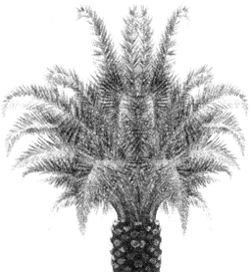
Soil
Without soil, most of the plants would not exist. And in the absence of plants, other forms of life would not exist. Soil consists of the following components:
(1) Soil particles of different sizes (like stones or gravel, sand, silt, clay) – particle size in the sand are bigger than silt and clay particles, but smaller than gravel.
(2) Organic matter or humus
(3) Soil water
(4) Soil air
(5) Soil organisms
Organic matter(humus) provides fertility to the soil and is formed by the death and decay of plants and animals.
The best soil for growing plants is one that is a mixture of clay, silt, and sand. Such soil is called loam soil.
Soil serves several functions – provides anchorage to the plants, provides water and nutrients to the plants, and allows soil organisms like earthworms, bacteria, insects, and burrowing mammals to live inside it. For growing crops, man provides additional manures and fertilizers artificially to the soil, enriching its mineral content.
7. INTERDEPENDENCE AMONGST LIVING ORGANISMS
All living things depend on other living things, directly or indirectly. For example, a deer needs grass to live, and a lion needs deer to live. In this example, a deer is directly dependent on grass, and the lion’s dependence on grass is indirect. In a similar manner, all the plants, birds, reptiles, fish, insects, etc., are connected to each other, and depend, directly or indirectly, on each other. In other words, it also means that the survival of all the living things is dependent on each other.
For a living thing to survive, it must exist in a certain proportion and allow other living things to exist. Living things cannot afford to exist without any check. For instance, if there are too many lions, they will kill all the deer. On the other hand, if there are too many deer, they will eat too much grass, and not leave any grass for the other animals. Thus, different living organisms must exist to survive and allow others to survive. The result is a complete balance in nature.
Dependence Of Animals On Plants
Animals depend upon plants in various ways.
1. For Food: All animals depend for their food, directly or indirectly, on green plants (Figure).
2. For Oxygen: Plants give out oxygen during the process of photosynthesis. The oxygen, so liberated, is used by animals and plants for their respiration.
3. For Shelter: Some animals depend on plants for shelter. They make their homes in holes in the trees. Some birds build their nests in the trees. Many insects like the grasshopper, moth, ants, beetle live in trees. Monkeys also live in trees.
The interdependence of Plants and Animals
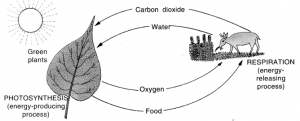
Dependence Of Plants On Animals
1. For Carbon dioxide. Plants need carbon dioxide to prepare food through photosynthesis. This carbon dioxide comes from animals during respiration (Figure).
2. For Pollination. In some plants, pollination is brought about by insects, birds, and bats. Without pollination, formation of seeds in these plants would not be possible.
3. For Seed dispersal. Seed dispersal in many plants is through animals and even man. Fruits are eaten by animals such as the birds that carry them to distant places. Finally, the seeds are passed out in their excreta without any damage. Some seeds possess spines or hooks that enable them to stick to the body of animals and thereby help in their being carried from one place to the other. Finally, man himself is a great disseminator of seeds, especially of those which he uses, for his food and other needs.
8. DEPENDENCE OF HUMANS ON PLANTS AND ANIMALS
1) For Food
(a) From plants
(i) Cereals — Rice, wheat, maize, barley
(ii) Pulses — Moong, gram, beans, arhar
(iii) Vegetables — Onion, potato, spinach, brinjal, radish, carrot, beetroot
(iv) Fruits — Mango, apple, banana, grapes, pineapple, orange
(v) Beverages — Tea, coffee
(vi) Sugar — Sugarcane
(vii) Spices — Turmeric (Haldi), pepper, chilli, clove (loung)
(viii) Oilseeds — Groundnut, coconut, mustard
(b) From animals
(i) Milk — Cows, buffaloes, goats
(ii) Eggs — Hen
(iii) Meat or Fish — Goats, sheep, fish
(iv) Honey — Honey bees
2) For Clothing
(a) From plants
Fibers from cotton and jute
(b) From animals
(i) Leather — Hide (skin) of buffaloes, sheep, rabbits, and even snakes.
(ii) Silk — Silk moth insects (cocoons)
(iii) Wool — Fur of sheep
3) For Medicines — Most of the medicines are obtained from plants.
(i) Penicillin — Fungus Penicillium
(ii) Quinine — Bark of Cinchona (cure for malaria)
4) For Timber or Wood (Furniture, housing, ship, etc.) Trees such as teak, sal, deodar.
5) For Paper The wood pulp of bamboos and eucalyptus.
6) For Rubber (For tyres, shoes, mattresses, etc.) Latex from the rubber tree.
7) For Perfumes Dyes, Resins
8) For Fuel
9) For Ornamental and Landscape Purposes
A number of plants are grown in gardens and other places for aesthetic beauty.
10) Other Uses
(i) Plants prevent soil erosion by wind or water.
(ii) Certain plants like legumes enrich soil fertility.
(iii) A number of animals like horses, donkeys, and bullocks are used for transportation, for ploughing fields, etc.
(iv) Animals like dogs provide security to human beings.
9. GARBAGE AND ITS DISPOSAL
Waste accumulated in our surroundings and is ready for disposal is called garbage. Garbage is solid waste which includes domestic wastes, municipal wastes, and industrial wastes.
Domestic wastes are the wastes from our houses.
Municipal wastes are the wastes from schools, offices, roads, and shops.
Industrial wastes are the wastes discarded from industries and small factories.
Garbage Disposal
A large, low-lying area used to dispose of garbage is known as a dump.
A garbage dump is also used as a landfill. Garbage collectors collect waste and then dispose of it at garbage disposals.
Garbage dumps have flies, cockroaches, and mosquitoes, and later turn into breeding grounds for micro-organisms that may cause diseases. This is the reason why garbage dumps are usually located on the outskirts of a city.
In the long run, when garbage mixes with soil, it takes a longer time to decay making the soil loose.
The burning of agricultural wastes like dried leaves, husk, etc. releases smoke and harmful gases into the atmosphere. These harmful gases may cause respiratory diseases.
Components Of Garbage
Domestic wastes can be of two types namely, dry wastes and moist wastes. Wastes are collected in two separate types of bins.
Blue bins are used to dump recyclable wastes which include glass pieces, glass bottles, plastic waste, old batteries, polythene bags, etc.
Green bins are used to dump vegetable and fruit peels, food remains, tea leaves, eggshells, leaves, hair, tissue papers, etc.
a) Dry wastes or non-biodegradable wastes: Dry wastes include newspapers, metallic waste, plastic pieces, broken glass pieces, wooden blocks, and waste rags. These wastes are to be discarded into blue bins provided by the municipality. Dry wastes can be recycled and reused. At regular intervals of time, they are taken to recycling plants for the process of recycling.
b) Moist wastes or biodegradable wastes: These are the wastes that come from our kitchen. They include food remains, vegetable peels, fruit peels, garden waste. These are discarded into the green bins provided by the municipality. These can be composted to obtain manure. Moist wastes are also used to fill the low lying areas by converting them into landfills.
10. MANAGEMENT OF BIODEGRADABLE WASTES
Wastes can be decomposed and converted into organic manure by different processes.
a) Composting involves the conversion of biodegradable wastes into organic manure by burying them in the compost pits. These wastes are decomposed by the action of bacteria and fungi. It is a slow and simple process. It is a cheap process. It causes no harm to the environment.
Advantages of compost
Compost increases the fertility of the soil.
It increases the number of trace elements copper, manganese, molybdenum in the soil which are essential for growth.
Compost increases the water holding capacity of the soil. It also improves the texture of the soil.
b) Vermicompostinginvolves degradation of organic matter into fertile manure by using a special type of earthworms called red worms. The nutrient-rich manure is called vermicompost. The process of preparing manure with the help of red worms is called vermicomposting. The red worm is a type of earthworm that lives in soil rich in organic matter. Organic soils are rich in nitrogen and carbon with plenty of moisture and microbes.
Method of Vermicomposting
- A vermicomposting pit is made with a wooden box or big cement rings.
- A mesh is spread at the bottom of the pit.
- Vegetable waste, fruit waste, a waste paper that is not shiny or coated with plastic, is spread over the mesh.
- Water is sprinkled to create moisture so that the red worms can live.
- A vermicomposting pit takes nearly two to four weeks to completely convert waste into
- The red worms possess a special structure called gizzards with which they grind food A red worm eats food equal to its weight every day. Their castings are used as rich manure. This is called vermicompost.
- Vermicompost should be removed from the pit and dried before use.
- Vermicompost can be made in 3 -4 weeks.
- Redworms do not survive in too hot or too cold conditions.
c) Landfill is another method of managing biodegradable wastes. Landfills are large areas used for waste disposal. Garbage thrown into landfills decomposes very slowly and makes the soil loose. As the landfill becomes full, the garbage decomposes and mixes with the soil. This land can be cleaned and converted into a park.
11. ROLE OF HUMANS IN THE BALANCE IN NATURE: ECOLOGICAL CRISIS
Some of the ways in which man’s actions have upset the natural balance are as follows:
1. Indiscriminate felling of trees and clearing of forests (deforestation) has led to soil erosion and floods. Many animals have been rendered homeless by the destruction of forests. Availability of food has also been affected. As a result, many animals have moved from forests to areas inhabited by man, and have become man-eaters.
Deforestation has also adversely affected the climate. Temperatures have risen, carbon dioxide concentration has increased, and rainfall has decreased.
2. Hunting of animals has led to a disturbance in the food chains, thus upsetting the ecosystem. The killing of tigers on a large scale has increased the number of herbivores such as deer. These deer destroy the crops in turn.
3. Population explosion and excessive industrialization have led to pollution of air, water, and soil.
4. Indiscriminate and excessive use of insecticides and pesticides like DDT (DDT does not undergo degradation) have led to their accumulation in the bodies of fish through water, and it ultimately reaches man. DDT being toxic may prove harmful in due course of time.
In human beings, DDT causes severe health problems. In birds, it prevents the formation of eggshells. As a result, eggs break before they are hatched.
Thus, a man who uses DDT to protect his crops is himself faced with destruction by the same chemical.
The above-mentioned activities of man have brought about a crisis in the physical environment, that is, land, water, and air.
12. POLLUTION
Pollution is nothing but an undesirable change in the natural quality of the environment that may adversely affect a man and other living beings. The agents which cause pollution are called pollutants. Man is mainly responsible for pollution.
Types Of Pollution
There are five major types of pollution:
1. Air pollution 2. Water pollution 3. Land or soil pollution
4. Noise or sound pollution 5. Radioactive pollution
Pollutants, on the basis of their nature, can be of two types:
1. Bio-degradable 2. Non-biodegradable.
Bio-degradable pollutants are those which get decomposed by the activity of micro-organisms. So, if used within limits, pollution is avoided.
Example: Organic matter like manure, garbage
Non-biodegradable pollutants, on the other hand, do not decompose and thus accumulate in the atmosphere. Finally, these pollutants reach the body of living organisms through the food chain causing immense harm and even death.
Examples: DDT, plastics, lead, mercury.
Air Pollution
Air pollution is the contamination of air with smoke, dust, and harmful gases. These contaminants are the pollutants of the air.
Causes
1. Excessive burning of fossil fuels like coal, kerosene, petrol, and diesel.
2. Smoke from vehicles.
3. Smoke from factories and thermal power stations.
4. Deforestation (cutting down trees).
Effects
1. Disorders of the respiratory system (bronchitis and asthma).
2. Irritation in the eyes, nose, and throat.
Control Measures
1. Use of smokeless fuels to be encouraged and that of fossil fuels to be avoided.
2. Growing trees (afforestation) to purify the air.
3. Installation of tall chimneys with filters in factories so that their emissions are given out high up in the atmosphere.
Water Pollution
Water pollution is the contamination of water with pollutants like sewage, industrial wastes, and other harmful materials.
Causes
1. Discharge of sewage and detergents into lakes and rivers.
2. Human activities like bathing and washing of clothes.
3. Discharge of industrial wastes, fertilizers, and pesticides.
4. Defecation by humans and animals in or near water sources.
5. Oil spills from oil tankers.
Effects
1. Serious water-borne diseases like typhoid, cholera, jaundice, and dysentery in humans.
2. Aquatic plant and animal life are damaged or killed.
Control Measures
1. Sewage treatment — by physical and chemical means.
2. Recycling of industrial wastes.
3. Use of biological fertilizers and pesticides.
4. Provision for proper sanitary and hygienic conditions.
Land/Soil Pollution
Contamination of the land or soil with wastes like garbage, fertilizers, pesticides, metals, and plastics is called a land or soil pollution.
Causes
1. Improper disposal of garbage, glass bottles, plastics, metals, paper, medical wastes (syringes, cotton), etc.
2. Excessive use of fertilizers, pesticides, and insecticides to increase crop yield.
3. Dumping of radioactive wastes.
Effects
1. Useful soil micro-organisms are destroyed.
2. Plant growth is affected.
Control Measures
1. Proper disposal of garbage, away from residential areas.
2. Converting biodegradable wastes into useful products.
3. Excessive use of artificial fertilizers, pesticides, and insecticides to be avoided; the use of natural alternatives which are biodegradable to be encouraged.
4. Use of plastics to be banned.
5. Recycling technologies to be used.
Sound/Noise Pollution
Prolonged loud noise from different sources is called sound or noise pollution; it causes mental and physical harm.
Causes
1. Use of pressure horns; blaring of bands and loudspeakers during marriages and festivals
2. Radio, television
3. Bursting of crackers
4. Cars, motorcycles, airplanes
Effects
1. Damage to the ears; may cause partial deafness.
2. Sleeplessness
3. Affects the nervous system and causes mental depression
Control Measures
1. Ban on the use of high volume loudspeakers and excessive use of horns.
2. Ban on crackers
3. Putting a legal ban
4. Initiating public awareness campaigns.
In brief, it must be realized that man and nature need each other, and by hurting one, we wound the other. So, conserve and preserve Nature.
General Measures To Check Pollution
1. Do not cut trees, rather a plant trees.
2. Do not destroy flora (plants) and fauna (animals), to maintain the proper ecological balance.
3. Use bio-degradable substances, as far as possible.
4. Solid waste materials should not be thrown in water or in your surroundings. These materials should be properly disposed of.
5. Waste materials should be recycled. Recycled paper is a step in this direction.
6. The use of solar cookers and biogas should be encouraged. This would reduce the pressure on the burning of fossil fuels like coal.
7. Strict checks on the emissions from automobile exhausts should be enforced.
8. Industries should be made to strictly adhere to the anti-pollution steps, laid down by the government.
9. Chimneys of the industries should be very tall so that their emissions are given out high up in the atmosphere.
10. Industries should not be located in residential areas.








